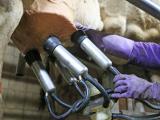Jan 17, 2007 (CIDRAP News) – In an effort to stretch the nation's supply of vaccines for a potential influenza pandemic, federal health officials today announced contracts totaling $132.5 million to help three companies develop dose-sparing substances, or adjuvants, to be used with H5N1 flu vaccines.
The Department of Health and Human Services (HHS) awarded a 5-year, $63.3 million contract to British-based GlaxoSmithKline (GSK) and a 5-year, $54.8 million contract to Swiss-based Novartis. In addition, Iomai Corp., Gaithersburg, Md., received a $14.4 million, 15-month contract, which could lead to an additional $114 million award, HHS announced in a news release.
The Novartis contract will help the company bring its MF59 adjuvant, used in seasonal flu vaccines for elderly people in Europe, to the United States, the company said. Iomai will use the funds to develop an adjuvant skin patch to be used with flu vaccines, while a GSK news release said only that the money would be used for an "innovative adjuvant technology."
The aim of the contracts, HHS said, is to put each company in a position to produce, within 6 months after the emergence of a flu pandemic, either 150 million doses of an adjuvant-based pandemic vaccine or enough adjuvant for 150 million doses of such a vaccine.
"The contracts also require each company to provide its proprietary adjuvant for U.S. Government–sponsored, independent evaluation with influenza vaccines from other manufacturers," HHS said.
If the H5N1 avian flu virus evolves into a pandemic strain, vaccines are expected to be in extremely short supply. HHS is stockpiling H5N1 vaccines, but in November the stockpile amounted to enough for only about 3 million people. And no one knows how effective the vaccines will be against an emerging pandemic strain. Hence HHS is funding efforts to make vaccine supplies stretch further and to produce vaccines faster than with the conventional method of growing them in chicken eggs.
With current technology, it would take about 6 months to start producing a vaccine well matched to the pandemic strain, HHS spokesman Bill Hall noted. "By having an adjuvant you can rapidly extend the number of people you can cover early on with vaccine," he told CIDRAP News.
In a news release, Novartis officials said their contract will be used to test the safety and effectiveness of the MF59 adjuvant in a pandemic flu vaccine and to support work on an MF59 production facility in Holly Springs, N.C. The vaccine will be grown in cell culture rather than in eggs. In May 2006 the company received an HHS contract to develop a cell-culture-based flu vaccine and a manufacturing facility for it.
Novartis said several published studies have indicated that MF59 may reduce the amount of antigen needed in H5N1 vaccines and may help such vaccines provide cross-protection against slightly different, or "drifted," strains of the virus.
The Novartis vaccine Fluad, which contains MF59, is licensed in Europe for preventing seasonal flu in people aged 65 and older, the company said. It said many studies have shown that the vaccine induced stronger antibody responses in elderly people than were seen with an unadjuvanted vaccine.
GSK will use the HHS contract to conduct "research and development leading towards licensure of antigen-sparing prepandemic and pandemic vaccines with adjuvant" to protect more people, according to a company statement. The contract gives HHS the option to provide another $44 million for "future clinical development programs" for antigen-sparing vaccines, the company said. Hall said the company's H5N1 vaccine is egg-based.
In July 2006 GSK reported that in a clinical trial, an H5N1 vaccine coupled with the company's adjuvant triggered a good immune response with only 3.8 micrograms (mcg) of antigen, as compared with 15 mcg of antigen in a typical dose of seasonal flu vaccine (for one flu strain). As noted in today's HHS statement, early trials of the (unadjuvanted) H5N1 vaccine in the current stockpile showed that it took two 90-mcg doses to induce what was considered a protective immune response.
The $14.4 million award to Iomai is intended to support completion of phase 1 clinical trials of a candidate vaccine with adjuvant, according to HHS. The company "may receive an additional $114 million in funding upon successful completion of the phase 1 trials."
An Iomai news release said the additional funding is the estimated amount needed to bring the combination of vaccine and dose-sparing patch to licensure.
The patch is applied to the skin over the site of vaccination, the company said. "Once the patch is applied, the adjuvant passes into the skin, targeting cells called Langerhans cells. Those specialized skin cells carry the adjuvant to the lymph nodes, where it works to boost an individual's immune response to the vaccine."
Michael T. Osterholm, PhD, MPH, director of the University of Minnesota Center for Infectious Disease Research and Policy, publisher of the CIDRAP Web site, praised HHS for awarding the contracts. "Adjuvants likely will play an important role in extending the number of doses that will be available once a pandemic strain is identified and vaccine production begins," he said.
He also expressed gratification that the Novartis contract will support development of a cell-based vaccine. Cell-based production "will definitely shave time off the production of the [pandemic] vaccine," although the pandemic strain will have to be identified first, he said.
"If we actually had licensed cell-based vaccines with an immunogenic adjuvant, it would put us in a much better position in the US to respond to pandemic influenza," Osterholm said.
See also:
Jan 17 HHS news release
http://www.hhs.gov/news/press/2007pres/01/20070117b.html
Jan 17 Novartis news release
http://cws.huginonline.com/N/134323/PR/200701/1098644_5.html
Nov 20, 2006, CIDRAP News story "HHS awards 3 contracts for more H5N1 vaccine"
Jul 26, 2006, CIDRAP News story "Glaxo says its H5N1 vaccine works at low dose"




















